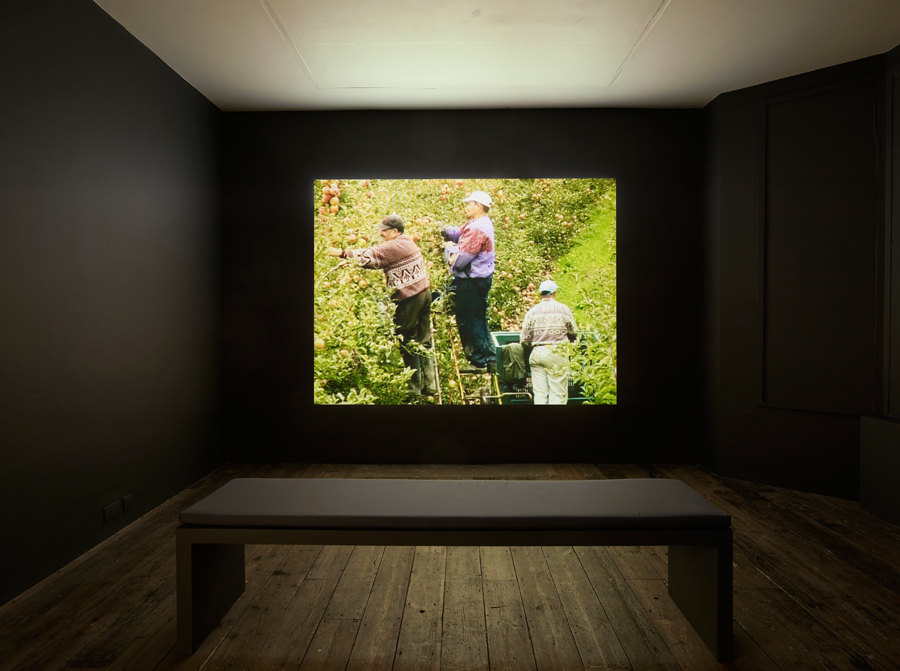Katharina Grosse
South London Gallery, London, UK
South London Gallery, London, UK

There’s a glamorous, transgressive quality to Katharina Grosse’s ‘This Drove My Mother up the Wall’. Denuded of all scenography, stripped back to its prim, institutional walls, the Victorian interior of South London Gallery has been sprayed voluptuously with jets of laurel green and indigo. There’s a metallic tang of tarnished copper, offering a sense memory of Sigmar Polke’s experiments with sea snails, producing Tyrian purple built up in iridescent layers. Spurts of hazmat orange disintegrate in auroral plumes. It’s an exciting space to be in: during my time in the gallery a five-year-old girl dropped by on her third visit.
As Grosse’s pre-school fans appreciate, in painting all over the walls, the artist has done something very naughty indeed, and the title suggests that she knows it. It evokes thoughts of Marina Abramović as a furious teenager, covering the walls of her bedroom in brown boot polish, and of Laura Owens painting the colouring book pages of a kid too young to know to keep within the lines. As if adding an extra layer of defiance, Grosse covered much of the floor of the space with a foam stencil, which she painted over. What we see in ‘This Drove My Mother up the Wall’, she suggests, is not even the painting itself – it’s the mess that she’s left behind in the process of creating another work that has been removed: we’re being offered Jackson Pollock’s floor, not his Full Fathom Five (1947).

South London Gallery is just a short walk from John Latham’s Flat Time House. First experimenting with a spray gun in the 1950s, Latham later described this mechanized paint application as offering a new approach to form, ‘both abstract and referential in “image”’, permitting the creation of works that could be read mathematically and ‘as memory trace’. Like Latham, Grosse fully indulges in optical play in her use of sprayed paint. As her colour frays down to freckles at the edges, light seems to fall where there is no light; faint mists of paint suggest rough texture on a flat surface; dominating washes of pigment flatten out door frames and picture rails. Through shifting intensities of paint, she sculpts the gallery space for the eye.
As with Agnès Varda’s film The Gleaners and I (2000), which Grosse has selected to be shown in an upstairs gallery during the exhibition, we are intensely aware of the artist’s body and the role it plays in the creation of this work. In The Gleaners Varda shows us the pearly roots of her dyed hair and the silky folds of skin on the back of her dappled hand. Both, she says, tell her: ‘C’est bientôt le fin’ (the end is soon). By contrast, Grosse is the human expanded rather than the human diminished. She paints in a full body suit using vast canisters. Her long-barrelled spray gun wouldn’t look out of place wielded by Ellen Ripley in Alien (1979): it’s a body extension, a cyborgian prosthetic offering superhuman reach.

In a 2011 interview, Grosse spoke of her large-scale spray-painted works in terms of theatre: ‘The audience is not within the sphere of my influence. Rather, my work is in the sphere of their influence. What appears on the image field or on the stage is not subordinate to existing reality. It constitutes that reality.’ Mere months after that interview, the word ‘selfie’ intruded into the vernacular. It is notable that today, Grosse’s works in which theatrical illusion overlays reality have become, in turn, sites for another layer of image making: part of a flourishing accidental genre in which the artwork performs as a frame for pictures of its visitors.
Main image: Katharina Grosse, This Drove my Mother up the Wall, 2017, installation view, South London Gallery, acrylic on wall and floor. Courtesy: South London Gallery; photograph: Andy Keate

























